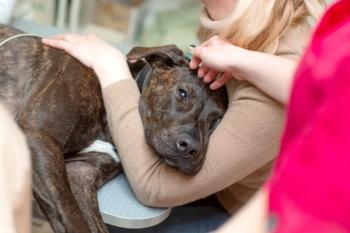
- dvm360 February 2022
- Volume 53
- Issue 2
10 Dental hacks to enhance your veterinary practice in 2022
An oral care expert recommends products, protocols to better serve clients, patients.
Veterinary dentistry services may be made more efficient with a little help. Here are some useful hacks for helping veterinary professionals provide these services and improve patient experiences:
1. Flowable hemostatic agent
A great cause of operative dentistry fear and anxiety in veterinarians is excessive bleeding. VETIGEL is a plant-derived injectable gel that quickly stops bleeding on external and internal wounds. Its name is coined from Medi-Gel, from the video game series Mass Effect. The hemostatic gel uses a hemophilic polymer made from polysaccharides that forms a mesh which seals the wound. VETIGEL is manufactured by Cresilon Inc.
2. Cloud based dental charting
Dental charting completed on paper is often messy, hard to interpret, and may get lost. Electronic charts available from vetdentalcharts.com allow the veterinarian and technician to record oral pathology using an Apple iPad, a tablet with a stylus, or a desktop computer. The process is so simple that you can record periodontal probing depths and write or draw pathology on the chart, or use the advanced version with dental nomenclature. It is even possible to customize your own dental terms. The program allows you to upload high resolution clinical photographs, hang radiographs and produce take-home instructions for clients. The charts are available for a trial period before subscribing at www.app.vetdentalcharts.com.
3. Dual computer monitors servicing each dental operatory table
The ability to view the radiographs and dental chart on eye level monitors greatly improves the dental diagnostic workflow.
4. Embrace Oral Cytology
Timely examination of cells from oral masses can be invaluable toward immediate diagnosis and treatment planning. Cotton tipped applicator sticks can be used to obtain cells from open lesions. Fine needle aspiration is best used to acquire cells from lesions that appear to be covered with oral mucosa. Cellular pleomorphism, anisocytosis, anisokaryosis, nuclear clumping, and the nuclear/cytoplasm ratio help to differentiate between benign and malignant lesions. Often this will save time and the need for a second surgery. For those that are not comfortable reading cytology, there is laboratory equipment that will digitize stained cytology samples which can be sent out for a quick pathologist opinion.
5. 4/6-Handed dentistry-call out results
Dental workflow includes the veterinary assistant scaling and polishing the teeth, performing intraoral radiography and dental charting. With 4-handed dentistry the assistant also charts the veterinarian’s recommendations for care and monitors anesthesia parameters. Six-handed dentistry frees up 1 assistant to monitor anesthesia while another assistant helps with surgery every 5 minutes.
6. #11 scalpel blade Vs. #15 scalpel blade
The #11 blade’s sharply angled point allows pinpoint accuracy incising the gingiva for flap exposure. The #15 scalpel blade will also work but may incise more area than needed for the procedure.
7. # 2 flat molt periosteal elevator
This small sharp instrument is wonderful to use when separating the attached gingiva from the periosteum. When ordering, be sure to specify the flat version vs. curved.
8. Sharpen every hand instrument every time
Hand instruments become dull after use. Instrument sharpening is quick and easy. The Arkansas or Indian stones, and sharpening oil is available from all dental suppliers.
9. Use a football diamond bur to smooth out extraction sites
Often the alveolar margin appears sharp to the touch after the tooth is delivered from an extraction site. Before closure, use a diamond football bur to smooth out the sharp areas. Your patient will thank you.
10. Monitor anesthesia patients as well as post anesthesia patients
Our client’s greatest fear with dental procedures is general anesthesia. Studies have shown most adverse anesthesia events do not occur during the procedure but during recovery while caged. Monitoring the patient’s vital signs once they are off the table can provide a visually generated heads-up allowing timely intervention. The Vetcorder Pro provides good reason to recover every patient with a monitor. It’s Bluetooth capability allows vitals to be mirrored to a smart phone or tablet, and no longer requires a human to sit cage side with that patient. Separate fees can be applied for monitoring to cover the expenses involved.
(Bonus) # 701S- surgical bur
Often the 19mm friction grip burs do not reach deep enough for operative dentistry. The 701 tapered crosscut surgical bur is 25mm long, providing extra reach for root exposure and tooth sectioning.
(Bonus #2) Daily Dental Wipes Vs. Daily Tooth brushing
Even though daily tooth brushing is the gold-standard, less than 5% of clients are compliant. With my own pointer I use a dental wipe (Vetradent) daily. The wipe is rubbed over the buccal and facial tooth surfaces and is followed by feeding a Veterinary Oral Health Council- accepted treat. She loves it!
Jan Bellows, DVM, DAVDC, DABVP, FAVD, owns All Pets Dental in Weston, Florida. He is a diplomate of the American Veterinary Dental College and the American Board of Veterinary Practitioners. He can be reached at (954) 349-5800; email: dentalvet@aol.com.
Articles in this issue
almost 4 years ago
Enter the 2022 dvm360® Hospital Design Competitionalmost 4 years ago
What’s new in 2022almost 4 years ago
Making room at the tablealmost 4 years ago
Do we need a paradigm shift in canine neutering?almost 4 years ago
Implementing virtual care in veterinary practicealmost 4 years ago
Commentary: compensating trainees as paid staffalmost 4 years ago
How research of an FIP treatment for cats is saving human livesalmost 4 years ago
At-home care is crucial to combating periodontal diseasealmost 4 years ago
The dilemma: approaching retirementalmost 4 years ago
Providing oral health services and public informationNewsletter
From exam room tips to practice management insights, get trusted veterinary news delivered straight to your inbox—subscribe to dvm360.




